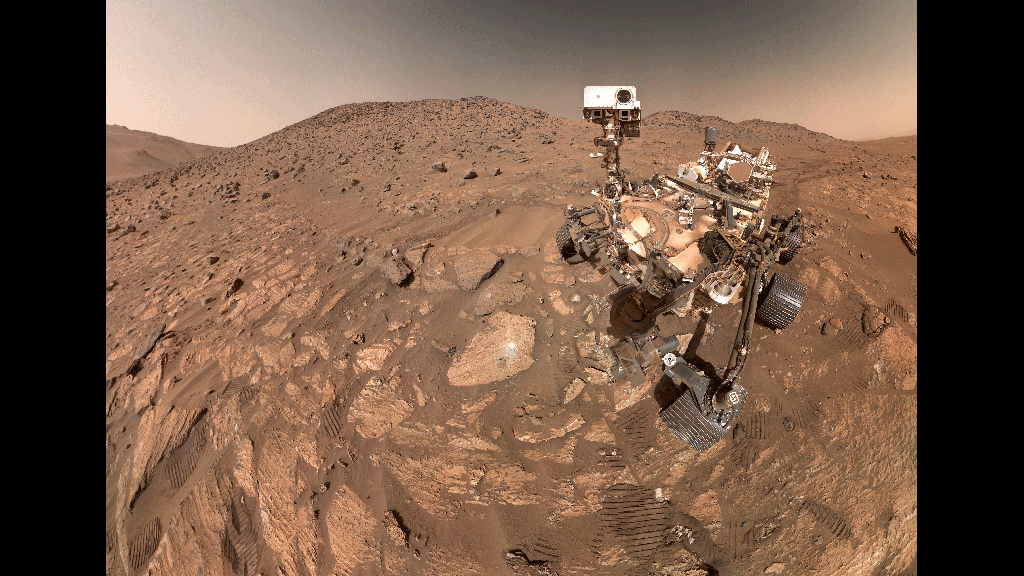Outer Space
Groundbreaking Mission Will Attempt the First Private Astronaut Spacewalk Next Week
Polaris Dawn is set to be the farthest humans have traveled from Earth since the Apollo program and will test new technology in a "radiation belt" surrounding our planet
Mysterious 'Wow!' Radio Signal Might Finally Have an Explanation—and No, It's Not Aliens
The infamous signal recorded in 1977 might have been a laser-like beam of radiation from a hydrogen cloud energized by a powerful, magnetic star, preliminary research suggests
Scientists Suggest Freezing Endangered Animals' Cells and Preserving Them on the Moon
Shadowed areas in lunar craters may be cold enough to safeguard species' DNA amid "climate disasters and social disasters" on Earth, according to Smithsonian-led research
A Rare 'Super Blue Moon' Will Be Visible Monday Night: What Does That Mean?
Tonight’s full moon will be bigger and brighter than usual, and it’s the third of four full moons this summer
Could These Carvings in Turkey Be the World's Oldest Lunisolar Calendar?
One researcher thinks the V-shaped markings engraved into a pillar thousands of years ago may represent the days of the year
NASA Retires Orbiting Telescope That Charted Asteroids for Over a Decade
NEOWISE, which looked for potentially hazardous objects in the solar system, received its last command on Thursday and will burn up when it re-enters Earth's atmosphere
Humans Could Warm Up Mars for Space Travelers by Spraying Tiny Metal Rods Into Its Atmosphere
Researchers propose a new technique for making the Red Planet more habitable by engineering heat-trapping nanoparticles from Martian dust
Inside Scientists’ Quest to Find the Secrets of Life in Four Grams of Asteroid Dust
NASA researchers are scrutinizing rocks and dirt brought to Earth from the asteroid Bennu
NASA Astronauts Launched on Eight-Day Mission Might Have to Remain on the ISS Until February
After technical issues on Boeing's Starliner spacecraft, the space agency says it's considering bringing the astronauts back to Earth on a SpaceX Crew Dragon instead
Meteorite Strikes Are the Primary Creator of the Moon's Thin Atmosphere, Study Finds
Researchers examined lunar soil samples collected during the Apollo missions to determine which weathering processes contribute most to replenishing the moon's atmosphere
Scientists Find Water Molecules in Lunar Rock Sample for the First Time
The samples from China's Chang'e 5 mission shed light on lunar resources that could be vital to future missions and habitations
How to Watch the Perseids, the 'Best Meteor Shower of the Year'
The annual celestial event is one of the year's most anticipated, and it will peak from August 11 to 12
Thousands of Moonquakes Rocked the Apollo Landing Sites in Less Than a Decade
A new study found 22,000 previously unidentified lunar seismic events recorded between 1969 and 1977
Mars Rover Finds Three Possible Signs of Ancient Life on a Single Rock
Scientists were cautiously optimistic about Perseverance's discovery, though they indicated further research is needed before drawing definitive conclusions
NASA's Curiosity Rover Accidentally Discovers Sulfur Crystals on Mars
The rover’s wheel cracked open a rock and revealed pure elemental sulfur, which researchers have never seen on the Red Planet before
How to Watch the Southern Delta Aquariids Meteor Shower
Though not as prolific as the Perseids, this annual spectacle is 'scientifically interesting' because its comet of origin remains a mystery
See 25 Stunning Images of the Cosmos From the Chandra X-Ray Observatory as It Celebrates 25 Years in Space
Chandra, the world’s most powerful X-ray telescope, has been peering at black holes, stellar explosions and dark energy for a quarter-century
NASA Cancels VIPER Moon Mission After Spending $450 Million to Build a Rover
The project was intended to look for water ice in the shaded craters on the lunar south pole
Apollo Astronauts Left American Flags, Boots and Even Poop on the Moon. Here's Why These Artifacts Matter
Fifty-five years after the first human lunar landing, scholars and experts are looking to preserve the past as more nations and companies undertake moon missions
Astronomers Propose New Criteria to Classify Planets, but Pluto Still Doesn't Make the Cut
The new definition would define planets based on mass, rather than more ambiguous shape and size characteristics
Page 1 of 72
:focal(1250x833:1251x834)/https://tf-cmsv2-smithsonianmag-media.s3.amazonaws.com/filer_public/01/b7/01b71e0b-83ea-4d8b-95cb-39951dae990a/53934016370_5349d0f815_o.jpg)
:focal(307x258:308x259)/https://tf-cmsv2-smithsonianmag-media.s3.amazonaws.com/filer_public/48/6e/486ede95-127a-4131-ac00-feacc81cff2b/wowcl.jpg)
:focal(335x191:336x192)/https://tf-cmsv2-smithsonianmag-media.s3.amazonaws.com/filer_public/9b/b3/9bb31979-ca72-4d7e-8451-184a72b98133/lroc-moon-south-pole-illumination-2-670x380.png)
:focal(2048x1375:2049x1376)/https://tf-cmsv2-smithsonianmag-media.s3.amazonaws.com/filer_public/81/d4/81d43b86-bf2b-4552-b96c-4fd10f5e797e/moonrise-at-vasquez-rocks-credit-nasa-preston-dyches-cc-by-nc-20.webp)
:focal(1697x1276:1698x1277)/https://tf-cmsv2-smithsonianmag-media.s3.amazonaws.com/filer_public/4c/4d/4c4d526e-4387-46fa-9d82-60e2c97f19af/gobekli_tepe_urfa.jpeg)
:focal(385x220:386x221)/https://tf-cmsv2-smithsonianmag-media.s3.amazonaws.com/filer_public/ec/8a/ec8a9a7b-cf9a-455c-a3d9-24d09762caef/pia17254_modest.jpg)
:focal(320x320:321x321)/https://tf-cmsv2-smithsonianmag-media.s3.amazonaws.com/filer_public/a7/42/a742946b-581b-4795-bb7b-a2d00f2888d5/pia08636orig.jpg)
:focal(800x602:801x603)/https://tf-cmsv2-smithsonianmag-media.s3.amazonaws.com/filer_public/77/0d/770d8e16-63a4-42f3-ae86-0afc292c7ad7/airlock-2_web.jpg)
:focal(1073x273:1074x274)/https://tf-cmsv2-smithsonianmag-media.s3.amazonaws.com/filer_public/41/d3/41d3ffea-2cd6-4ca7-804f-7ded9087e10e/wilmore_and_williams.webp)
:focal(1952x1952:1953x1953)/https://tf-cmsv2-smithsonianmag-media.s3.amazonaws.com/filer_public/58/05/58052866-392d-470b-9b8a-a8bcfbb10181/as11-40-5948orig.jpg)
:focal(1278x405:1279x406)/https://tf-cmsv2-smithsonianmag-media.s3.amazonaws.com/filer_public/a8/30/a8306f31-be26-40e2-bb1a-23455a3b61ca/fullmoon2010.jpg)
:focal(960x695:961x696)/https://tf-cmsv2-smithsonianmag-media.s3.amazonaws.com/filer_public/d2/da/d2da1779-6e01-4735-ba7e-03bbc828e402/nhq202108110002large.jpg)
:focal(452x456:453x457)/https://tf-cmsv2-smithsonianmag-media.s3.amazonaws.com/filer_public/60/27/6027ba76-7bfe-46a1-9501-8d116a7a58fb/as11-40-5947.jpg)

:focal(1024x575:1025x576)/https://tf-cmsv2-smithsonianmag-media.s3.amazonaws.com/filer_public/38/bb/38bb7442-9862-40b8-89ff-a095e76d9abb/1-pia26309-curiosity-views-16x9-1.jpeg)
:focal(1500x871:1501x872)/https://tf-cmsv2-smithsonianmag-media.s3.amazonaws.com/filer_public/8a/bd/8abd6e51-d12a-44c5-915e-6c10520b20ed/gettyimages-1411415005.jpg)
:focal(432x335:433x336)/https://tf-cmsv2-smithsonianmag-media.s3.amazonaws.com/filer_public/bf/5a/bf5a2818-a7ca-4084-83ba-822ca14df256/25th.jpg)
:focal(1920x1097:1921x1098)/https://tf-cmsv2-smithsonianmag-media.s3.amazonaws.com/filer_public/b9/0c/b90c6b22-5a8b-437d-ae2f-8b8c50bff9da/acd20-0047orig.jpg)
:focal(2076x2076:2077x2077)/https://tf-cmsv2-smithsonianmag-media.s3.amazonaws.com/filer_public/d4/1a/d41ad02d-a810-4130-8b34-495c3d291ffb/as11-44-6551_orig.jpg)
:focal(1051x567:1052x568)/https://tf-cmsv2-smithsonianmag-media.s3.amazonaws.com/filer_public/00/e2/00e2a283-4c55-4442-8304-5382614f5ef3/pia11800large.jpg)